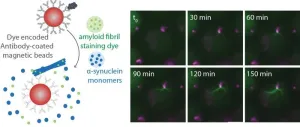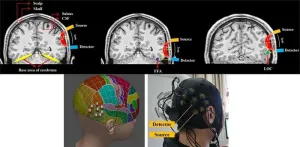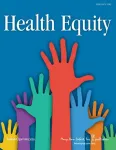(Press-News.org) Researchers at McMaster University have discovered a molecular “barcode” system used by disease-causing bacteria to distinguish between beneficial and toxic molecules.
Published in the Proceedings of the National Academy of Sciences (PNAS), the new study shows that many bacteria can figuratively scan genetic codes to learn which proteins to keep and which proteins to expel into the environment.
According to researchers, those proteins that are expelled are often toxic to human cells, making the ability to differentiate between proteins vital to a bacterium’s capacity for causing infectious disease.
“Proteins are one of the fundamental building blocks of life,” explains John Whitney, an associate professor in the Department of Biochemistry and Biomedical Sciences at McMaster and the lead investigator on the study. “They quite literally allow bacterial pathogens to do everything that they do. And while the vast majority of proteins remain inside bacteria to carry out functions like metabolism, there is a very small subset that act outside of the organism — like toxins.”
Whitney, a member of the Michael G. DeGroote Institute for Infectious Disease Research, says that although the bacterial secretion system and the toxins themselves have long been studied, it was not understood how bacteria discriminated between toxic and non-toxic proteins prior to the study.
Whitney’s lab, led by biochemistry graduate students Prakhar Shah and Timothy Klein (now a postdoctoral fellow at the University of California, San Francisco), questioned how three fundamentally different toxins could all be secreted by the same bacterial secretion system.
“There were no known similarities between the toxins — they don’t look anything alike, and they don’t do anything similar,” Whitney says. “Our rationale was, for them to all pass through the same protein secretion machine, there must be something common between them.”
Sure enough, there was. Each toxin shared a “domain,” which Whitney colloquially compares to a barcode. He says that while the barcode was shared by all three toxins under study, it was absent from the other three-thousand-or-so proteins in the bacteria, indicating that it serves as the export signal.
Shah, who co-first authored the study with Klein, says the team was able to prove this concept experimentally through a combination of genetic, biochemical, and structural approaches, including important “X-ray crystallography studies” that allowed them to purify the proteins and get a clearer view of the so-called barcodes and how they functioned.
The research team believes that this new information could eventually have a range of important biotechnology and infectious disease-related applications. In particular, Shah notes that the findings are relevant to our understanding of an array of gram-positive pathogens, including the kinds of bacteria responsible for serious infectious diseases like tuberculosis and listeriosis.
“A lot of pathogens use this system,” Shah says. “Therefore, our discovery has important implications on our understanding of the virulence strategies used by a wide range of human pathogens.”
---
To arrange an with John Whitney, you can email him directly at jwhitney@mcmaster.ca.
For any additional assistance, contact Adam Ward, media relations officer with McMaster University's Faculty of Health Science at warda17@mcmaster.ca.
END
McMaster researchers discover molecular ‘barcode’ used by bacteria to secrete toxins
2024-01-08
ELSE PRESS RELEASES FROM THIS DATE:
Migrants can be ‘transformative force’ for sustainable development
2024-01-08
Well-managed migration can enable migrants to boost sustainable development, research shows.
Sustainable development means enhancing wellbeing in ways that equitably meet needs of present and future generations.
Migration is often viewed as a threat to this – and to stability and security – while the benefits for migrants and host nations and regions are overlooked.
The new research – a set of studies published in the journal Proceedings of the National Academy of Sciences – shows new policies are needed for managing migration to maximise sustainability, and to minimise involuntary displacement due to conflict or disasters.
The ...
Novel test holds promise for detecting Parkinson’s disease early
2024-01-08
Novel Test Holds Promise for Detecting Parkinson’s Disease Early
Investigators from Brigham and Women’s Hospital and the Wyss Institute are working together to develop a new approach to detect and quantify minute amounts of a biomarker of Parkinson’s disease and related disorders at early stages
The platform has the potential to create early applicable molecular diagnostics, improve clinical trials, and facilitate drug screening
(Boston) — In the development of Parkinson’s ...
Protecting coral ‘nurseries’ as important as safeguarding established coral reefs
2024-01-08
When imagining corals, the picture that comes to mind is usually a stationary one: a garden of rock-like structures covering sections of the ocean floor. Reef conservation efforts typically focus on preserving established coral and protecting them from known stressors such as pollution, overfishing and runoff from coastline populations.
However, new research near Miloliʻi in the southwestern part of Hawai’i Island shows that identifying and protecting marine ecosystems, both down-current and up-current of coral reefs, specifically areas where coral larvae are more likely to survive and thrive, is crucial to future coral conservation and restoration efforts—especially ...
Nutrition needs drive bee appetites
2024-01-08
FORT COLLINS, Colo., Jan. 8, 2024 — What’s all the buzz about? Most garden enthusiasts know that certain flowers can attract pollinators. New research helps explain why, and also provides more details about how the nutrition found in plant pollen may determine which specific bee communities might favor your garden. On a larger scale, this research may help fight against pollinator declines through better design of rangeland restoration projects.
Scientists at the USDA Forest Service’s ...
Using spectroscopy to measure visual recognition
2024-01-08
The brain is not only the most complex organ of the human body, but also one of the most difficult to study. To understand the roles of different regions of the human brain and how they interact, it is crucial to measure neuronal activity with awake subjects while they perform controlled tasks. However, the most accurate measurement devices are invasive, which greatly limits their use on healthy humans in real-life settings.
To overcome this major obstacle, scientists have come up with ingenious techniques to measure brain activity in safe and ...
New research aims to develop novel therapeutic for glaucoma
2024-01-08
INDIANAPOLIS—Researchers at Indiana University School of Medicine are using a novel approach to hopefully develop a new therapy for glaucoma, a complex disease that eventually leads to blindness, thanks to a new five-year, $2 million R01 grant from the National Eye Institute.
“Glaucoma is a silent, underdiagnosed, costly and debilitating disease,” said Tasneem Sharma, PhD, assistant professor of ophthalmology and lead investigator on the project. “It occurs when there is ...
Roundtable on efforts toward achieving health equity
2024-01-08
In the Roundtable titled “A Glimpse at How Stakeholders Are Working Towards Achieving Health Equity,” published in the peer-reviewed journal Health Equity, two expert panel discussions examine efforts to achieve maternal health equity and changes that health systems can make to operationalize health equity. Click here to read the Roundtable now.
The moderator of the panel discussion titled “Efforts to Achieve Maternal Health Equity Today” is Laurie Zephyrin, MD, MPH, MBA, Senior Vice President, Advancing Health Equity, The Commonwealth Fund. The discussion focuses on what health systems can ...
100 years of lifesaving work and counting: Happy Birthday to the American Heart Association
2024-01-08
Embargoed until 1 p.m. CT/2 p.m. ET Monday, Jan. 8, 2024
DALLAS, Jan. 8, 2024 — From humble beginnings as a small professional health society formed by six cardiologists in Chicago in 1924, the American Heart Association has emerged as the nation’s oldest and largest voluntary organization dedicated to fighting heart disease and stroke. Uniting more than 35 million volunteers and supporters and more than 2,900 employees, the Association today is a global force transforming the way the world understands, treats and prevents cardiovascular and cerebrovascular ...
Virginia Tech researchers find drugs used to treat Type 2 diabetes reduce alcohol cravings, use in individuals with obesity
2024-01-08
In social media posts on the community network Reddit, users reported reduced cravings for alcohol when taking drugs intended to treat Type 2 diabetes and obesity.
Across a number of threads — with titles such as “Did scientists accidentally invent an anti-addiction drug?” and “I don't know if this is a side effect but ... Mounjaro makes me drink less!!!!!” — users reported a changing relationship with beer, wine, and liquor.
An analysis of those posts, together with a remote study of individuals with obesity who reported using semaglutide ...
Rensselaer researcher helps scientists make sense of vast amounts of molecular data
2024-01-08
Thanks to technological advances, scientists have access to vast amounts of data, but in order to put it to work and draw conclusions, they need to be able to process it.
In research recently published in Genome Biology, Rensselaer Polytechnic Institute’s Boleslaw Szymanski, Ph.D., Claire and Roland Schmitt Distinguished Professor of Computer Science and director of the Network Science and Technology Center, and team have found a method that effectively organizes and groups the data for a variety of applications. The process is referred to as clustering ...






